What do you say when you don’t know what to say? In the wake of the tragedy at Oxford High School, our Pediatric team created a list of resources to help parents talk to their child(ren) about school shootings. If you or your child need help, call your IHA Pediatric Practice. We’re here for you.
Author: Trinity Health IHA Medical Group
Take 2: Type 2 Diabetes
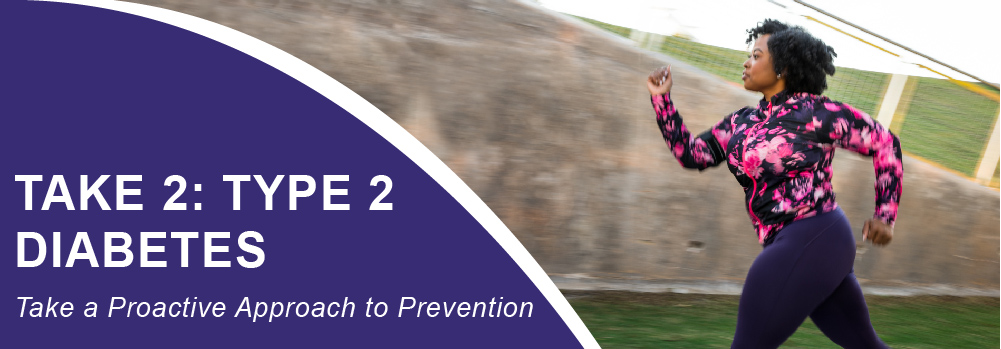
Take a proactive approach to preventing Type 2 Diabetes.
Author: Tendai Thomas, MD, FACP
Diabetes is a chronic disease that affects one in ten Americans today. Diabetes occurs when your blood sugar levels are too high. In normal circumstances, your pancreas is able to produce a hormone called insulin which regulates and maintains normal blood sugar levels. However, with diabetes, this process breaks down, causing blood sugar levels to rise to concerning levels. Diabetics have problems with high blood sugars due to a lack of insulin, or because their body does not know how to use insulin well. It is important to either avoid developing diabetes or keep your diabetes well controlled because diabetes increases your risk for several other conditions including heart attacks, stroke, kidney disease, vision loss, nerve damage, and circulation problems.
There are two main types of diabetes. Type 1 diabetes often occurs in young individuals when the immune system attacks and destroys cells in the pancreas that make insulin. Subsequently, Type 1 diabetics need to take insulin every day to stay alive. Type 2 diabetes, which is much more common, tends to occur at an older age. Ninety percent of people with Type 2 diabetes are overweight or obese. These individuals produce insulin from the pancreas, but it is not used effectively to regulate blood sugar levels.
The top 7 risk factors for Type 2 diabetes include:
- Obesity
- Sedentary lifestyle (lack of physical activity or exercise)
- Unhealthy eating habits
- A family history of diabetes
- Increased age
- Hypertension and high cholesterol
- Diabetes during pregnancy
If you are at risk for developing Type 2 Diabetes, there are some steps you can take to delay or even prevent the diagnosis.
Start by knowing your risk level. Take this quiz from the American Diabetes Association to find out where you stand: https://www.diabetes.org/risk-test
Lose weight and keep it off. Maintaining a healthy weight is an important factor preventing diabetes. Losing 5% – 10% of your body weight can make a big difference in reducing your risk of getting the disease. Once you achieve your weight loss goals, work to keep the weight off.
Stick to a healthy eating plan. Reducing your daily calorie, carbohydrate and sugar intake is key to weight loss. Consume smaller portions at every meal, eat less processed and simple sugar filled foods, and avoid drinks high in sugar. Remember your food groups when meal planning for the week. A healthy diet includes a variety of foods from every group!
Exercise 5 days a week. Exercise provides many benefits to your health. Make a goal to get 30 minutes of exercise 5 days a week. You can also consider obtaining an exercise partner to help keep you focused and on target. If exercise hasn’t been a part of your routine, talk to your physician for ideas to start slowly and work towards your goal.
Don’t smoke. Smoking can contribute to insulin resistance and many other health conditions related to diabetes. If you do smoke, please talk with your doctor about different approaches you can take that will help you quit.
Go at your own pace. When we make major changes to our diet or activity level, it’s easy to get frustrated along the way. Go slowly and create goals that are realistic for you and your body. Start with small steps and small changes and work your way up!
Keep your physician in the loop. Make an appointment to discuss your concerns with your primary care physician. They will help determine what else you can do to reduce your risk for Diabetes, and if you have already been diagnosed, they can help prescribe and manage any medications necessary to keep you feeling your best!
If you have already been diagnosed with Type 2 Diabetes, there are several treatments for managing your diabetes. For all individuals, nutrition is the key element for managing diabetes. In addition, since most people diagnosed with Type 2 diabetes are overweight, lifestyle changes that include regular exercise and weight loss are extremely important. Other therapies include the use of oral medications, injectables, and insulin administration. Talk to your primary care physician to find the best treatment for you.
Cindy Elliott named president of IHA medical group
For Immediate Release
Contact:
Bobby Maldonado
248-858-6662
Bobby.Maldonado@stjoeshealth.org

ANN ARBOR, MI, (Nov. 17, 2021) – IHA, the medical group for Saint Joseph Mercy Health System and a member of Trinity Health, has appointed Cindy Elliott, RN, FACHE, to be its next president. Today’s announcement follows a unanimous vote from the IHA Governing Board and the Trinity Health Michigan Board, and Elliott’s successful leadership in the interim role for the past several months.
Elliott becomes just the third president in IHA’s 27-year history, after Mark LePage, MD, and the late William Fileti.
“Cindy has been part of the IHA family for more than 22 years and was the clear choice to lead Trinity Health’s largest multi-specialty medical group,” said Rob Casalou, president and CEO of Trinity Health Michigan. “We are fortunate to have a leader with Cindy’s skill, vision and values helping forge the future of care for communities here in Michigan.”
Elliott has extensive clinical and operational experience over her distinguished 30-year career. She joined IHA in 1999 as director of Medical Management and progressed to positions of higher authority. In 2007 she was appointed COO and in 2016 she became president and COO. Together with the team at IHA, Elliott has led the organization through several significant phases of growth – taking the medical group from 180 providers in 2009 to more than 1,000 providers serving 125 locations across six counties. She also led the effort in establishing IHA’s 24/7 Service Center, which in 2020 took in more than 3.4 million incoming phone calls from patients.
“Cindy is passionate about serving our community as if every single patient were a member of her own family,” said Robert Breakey, MD, chairman of the IHA Governing Board of Directors. “She is highly respected across IHA, is known for her caring and compassionate demeanor, and has a tremendous work ethic and drive for delivering outstanding results.”
Elliott earned her Bachelor of Science degree in Nursing and Master of Health Administration from Eastern Michigan University. She has completed the Healthcare Executive course with Harvard’s School of Public Health and is a Fellow with the American College of Healthcare Executives. She was an adjunct professor at Eastern Michigan University and has served on several boards, including EMU’s Physician Assistant Program Advisory Board and the United Way of Washtenaw County.
###
About IHA
Established in 1994, IHA is one of the largest multi-specialty medical groups in Michigan delivering more than one million patient visits each year, practicing based on the guiding principle: our family caring for yours. Led by physicians, IHA is committed to providing the best care with the best outcomes for every patient and an exceptional work experience for every provider and employee. IHA offers patients from infancy through senior years, access to convenient, quality health care with extended office hours and urgent care services, online patient diagnosis, treatment and appointment access tools. IHA is based in Ann Arbor and employs more than 3,000 staff, including more than 700 providers consisting of physicians, nurse practitioners, physician assistants, care managers and midwives in more than 100 practice locations across Southeast Michigan. IHA serves as the Medical Group for Saint Joseph Mercy Health System and a member of Trinity Health. To learn more about IHA, visit www.ihacares.com.
Medicine Cabinet Essentials
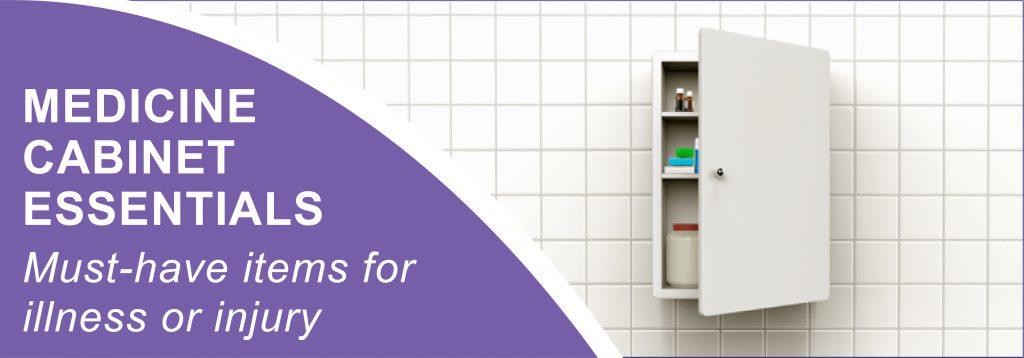
Must-have items for illness or injury
By Melissa Heinen, DO, MPH & Matthew Ajluni, DO
If you have tried to read an expiration date on a medicine bottle through blurry eyes in the middle of the night, this post is for you. If you have used four band-aids to cover a knee scrape on a crying child, this post is also for you. A well-stocked medicine cabinet is a must-have for every household. An illness or injury can sneak up on you at any point, day or night, and emergency trips to the drugstore in your pajamas are no fun. Here’s our (pediatrician & urgent care physician approved) medicine cabinet inventory list. As we head into cold and flu season, there’s no better time to stock-up.
Always remember to check with your child’s pediatrician or your primary care physician before giving or taking any medications and if the illness sticks around for more than a day or two. Always keep all medications out of reach of children.
Pain Relief
You will want to have both Acetaminophen and Ibuprofen for both children and adults, on hand. A children’s does is based on weight, so be sure to check with your pediatrician before giving your child a pain reliver.
• Acetaminophen:
o Medications containing acetaminophen can be used on headaches, muscle pains and fevers.
• Ibuprofen:
o This one is more effective for strains and sprains, but can help with fevers, too. (not to be used in children less than 6 months of age)
• Ice Pack:
o For bumps and minor injuries, have a reusable ice pack in the freezer or ready to fill with ice. Look for a soft or flexible ice pack for children.
Skincare
From bug bites to rashes to burns, the skin can be vulnerable to injury. Here are a few things to keep in your medicine cabinet to treat multiple issues. •Petroleum Jelly
o A home-care basic, this can be used to treat dry or irritated skin, eczema rashes and diaper rash.
• Hydrocortisone Cream 1%
o A tube of this over-the-counter steroid can help relieve symptoms from a bug bite, eczema, and other rashes.
Allergy Relief
• Antihistamine
o It’s good to have a non-drowsy and preferably a long-lasting version of this medication for everyone in the house. Allergy symptoms (itchy nose and eyes, sneezing or skin irritation) aren’t always just seasonal.
o Make sure to check with your child’s pediatrician or primary care physician before giving antihistamines for kids
• Saline Nasal Spray
o This can be helpful when noses are blocked, itchy or dry. Remember to spray away from the center of the nose, toward the ear.
o The saline drops are great for babies and toddlers who can’t blow their nose well
• Eye Drops
o Long days of screentime can result in tired, dry eyes. If you spend a lot of time in front of a computer, have a bottle of lubricating eye drops in the house. A couple drops of “tears” will refresh and soothe dry eyes.
Cold Treatment
• Vics VapoRub
o This topical cough suppressant can be purchased in different strengths for babies, kids and adults, but for babies and toddlers, it can be more irritating than helpful so it’s typically not recommended until the age of 4 years old. Check with your child’s pediatrician before using it on babies or children. Rub a ¼ – ½ a teaspoon of this ointment on the chest and back to help relieve congestion and cough symptoms. This is especially useful at night when a cough keeps you awake.
• Cough Syrup
o Although this medication cannot be given to kids under 6 years old (and you should check with your pediatrician for ages 6-11), it can relieve an annoying cough for older children and adults in your house. When purchasing cough syrup, look for one with dextromethorphan and guaifenesin.
• Nasal Aspirator
o Before babies know how to blow their nose, a nasal aspirator can help relieve congestion.
Wound Care
• Bandages
o Look for a box with a variety of sizes. From fingertips to knees, you never know what size you may need. If shopping for children’s bandages, let them pick a fun design. It might make their injury feel a little less traumatic.
• Roll of Gauze and Medical Tape
o When a bandage won’t cut it, have a roll of gauze or gauze squares handy to cover the boo-boo. Use the tape to secure the gauze in place.
• Antibiotic Ointment
o Use an ointment like Neosporin to keep minor cuts, scrapes and burns from getting infected.
Tools
• Thermometer
o For infants less than 6 months of age, use a rectal thermometer and a temporal or oral thermometer for older kids and adults.
• Tweezers
o Because splinters happen. Also, ticks can be safely removed with tweezers.
If you or a family member ever experiences an illness or injury more serious than the medicine cabinet and handle, contact your primary care physician or pediatrician.
Kids and the COVID-19 Vaccine: What Parents Need to Know
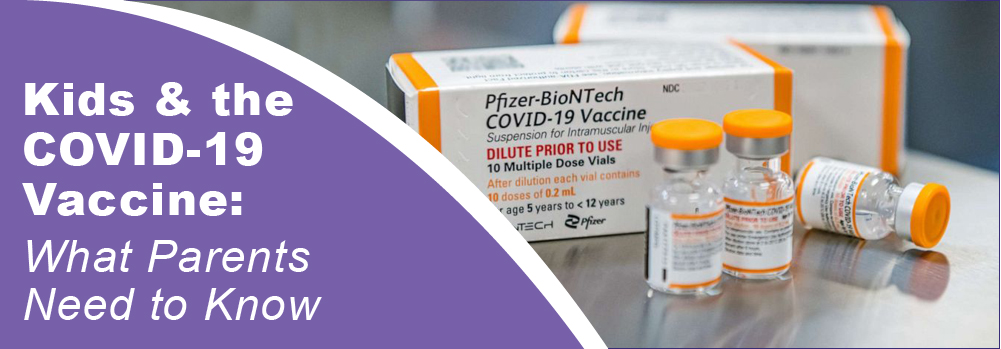
The COVID-19 vaccine is now available to children ages 5 to 11. Here’s what parents and children need to know about the safety and effectiveness of the vaccine, the possible side effects, and the benefits of getting vaccinated.
We Recommend the COVID-19 Vaccine for Children Age 5-11
On November 2, 2021, the Pfizer COVID-19 vaccine was authorized for emergency use for children ages 5-11. It is a 2-dose series taken three weeks apart. Each dose will be 1/3 the dosage of the adolescent/adult vaccine.
The vaccine for children ages 5-11 years is effective:
· 90-100% effective in clinical trials.
· There were no severe cases of COVID-19 in clinical trials.
· The vaccine works against Delta and other known variants of concern.
IHA Pediatrics has been vaccinating children ages 12 and up since May of 2021, and we have confidence that the Pfizer COVID-19 vaccine is safe and effective for our patients. As of October 2021, more than 11.1 million adolescents have been vaccinated against COVID-19 with the Pfizer COVID-19 vaccine.
Vaccine Appointment Available
IHA Pediatrics is now offering COVID-19 vaccines to current patients aged 5-11 however, availability may be limited.
We are working quickly to begin vaccinating our younger patients and will share more information on how to schedule your child’s COVID-19 vaccine in the coming days. Please continue to check our website and social media for the latest updates. If your child has an appointment scheduled at IHA Pediatrics in the next few weeks and is eligible for the COVID-19 vaccine, please ask for it at your appointment.
We also encourage you to search vaccines.gov to enter your zip code and easily find locations where vaccines are available.
Don’t Forget the Flu Vaccine!
It is more important than ever to stay healthy and protect yourself against preventable illnesses. It is safe to receive the flu vaccine at the same time as the COVID-19 vaccine.
Top Ten Questions Parents Ask about the COVID-19 Vaccine
Should I worry the vaccine is too “new”? No.
As of October 2021, more than 6.63 billion doses of the COVID-19 vaccine have been given worldwide, with more than 416 million doses in the United States. For adolescents alone, over 11 million doses of the COVID-19 vaccine tell us that this vaccine is no longer “new.” Scientists and pediatricians feel confident in the safety of the COVID-19 vaccine. Waiting puts you at higher risk for infection and illness.
The vaccine got to us fast due to:
- The vaccine research for mRNA started in 1961 and, in the last decade specifically, was focused on SARS.
- The vaccine was released more quickly than other vaccines because the production started before the clinical trials. This was due to the pandemic, which provided funding and resources to make that happen.
- Due to high disease rates in our community during vaccine development, we didn’t have to wait for a minimum number of cases for clinical trials, as is standard with vaccine development.
Will we need booster shots every year? We don’t know yet.
It depends on how many people get vaccinated and if the virus continues to spread and change. As the population becomes vaccinated, we reduce the spread of the virus, which helps to prevent it from continuing to change. We won’t need boosters if we are reducing and eliminating variants of COVID-19.
Does it affect puberty or fertility? No.
Based on our knowledge of mRNA, we are confident that the COVID-19 vaccine will not have long-term effects on puberty or fertility. mRNA cannot integrate with DNA or alter cells.
- Vaccine ingredients are cleared from the body quickly. mRNA is fragile and breaks down within 72 hours after injection. Ingredients do not linger in the body.
- Thousands upon thousands have gotten pregnant after receiving the COVID-19 vaccine.
- mRNA vaccine is not made up of COVID-19. It is only the protein.
- There are reports of menstrual cycle changes after the COVID-19 vaccine. This is due to the body mounting an immune response and a temporary side effect, like a fever.
What are the most common side effects for children? They can vary but are minimal.
- Side effects that have been reported are mild to moderate such as fever, fatigue, headache, chills, diarrhea, or muscle aches.
- More children reported side effects with the second dose compared to the first dose.
- Rare side effects can happen, such as swollen lymph nodes or skin sensitivity, but these are not long-term and resolved in most cases in a few days.
How do we know about long-term side effects? Decades of research.
Based on our knowledge of mRNA and the human body, we don’t expect long-term side effects since it breaks down in the body in 72 hours.
- As with all vaccines, including the COVID-19 mRNA vaccines, concerning side effects have occurred 6-8 weeks after injection. Vaccine development is based on decades of research. Scientists have done a rigorous review of all available data before approving for children. Our history of science tells us that if there are no side effects in those first few weeks, we are confident that concerns that arise with any patient decades later are unlikely to be related to any vaccine.
- mRNA cannot be converted to or inserted into DNA. It’s not scientifically possible.
How common is myocarditis for children after vaccination? Extremely rare.
Myocarditis means “inflammation of the heart muscle.” This can happen due to the robust immune response the vaccine can have on your body.
- It is very rare, about 26 cases per 1 million.
- Myocarditis has occurred rarely in some people following the mRNA COVID-19 vaccines, typically within a week after the second dose.
- The risk is highest in males 12–29 years of age.
- The risk of myocarditis after the mRNA COVID-19 vaccine is lower than the risk of myocarditis from the actual COVID-19 virus in adolescents and adults.
- When myocarditis occurs in those with COVID-19 infection, it is more common, severe, and lasts long-term.
- No cases of myocarditis were reported in the vaccine clinical trial among ~3000 children, ages 5–11 years.
- Symptoms of myocarditis are most commonly chest pain, difficulty breathing, or a fluttering heartbeat.
- Adolescents who have had this rare side effect are monitored closely. Most make a full recovery in 3-4 weeks by using anti-inflammatory medications like ibuprofen.
- No children have died of myocarditis after the COVID-19 vaccine.
My child had COVID. Do they need the vaccine? Yes.
- We know that “natural immunity” can be high at first. However, protection can drop off quickly or change based on circulating variants.
- Getting a vaccine, even for those who have already had COVID-19, strengthens your immune response.
- If you had COVID-19 once, it is possible to get a different strain again. The immune response after infection is not as focused. Evidence shows the vaccines protect you longer and for all the variants to date.
- Most importantly, the vaccine gives protection and prevents hospitalization for several of the COVID variants.
- Your child can get the COVID-19 vaccine once they are out of quarantine. There is no “waiting period,” as another strain may come, and the vaccine will protect from getting hospitalized.
Can children become very sick with COVID? Yes.
COVID-19 disease in children can range from no symptoms to severe illness.
- As of October 2021, over 6.3 million COVID-19 pediatric cases have been reported.
- Only 43% of children under 12 have natural immunity.
- 30% of hospitalizations for children with COVID-19 had no underlying medical conditions. As of October 2021, there were 5,217 MIS-C cases linked to COVID-19 in children. This multi-organ system effect makes children extremely ill and requires hospitalization, often in the ICU.
- Long COVID, or lingering COVID-19 symptoms, can lead to learning problems, heart problems, exercise fatigue with sports, and respiratory issues. This has been reported in about 8% of children who have had COVID-19.
- Since the pandemic began, over 600 pediatric deaths due to COVID-19 have been reported. It is now a top 10 cause of death for children in the United States.
What are the ingredients? Put simply, it’s fat, salt, electrolytes, and sugar.
- Lipids are the “fatty layer” that protects the delicate mRNA so it has time to work before getting chopped up. Polyethylene glycol (PEG), the most famous lipid, is also the main ingredient in MiraLAX (which you know about if your child has ever been constipated).
- The ingredients are only just salt, some electrolytes, mRNA, fat, and sugar. These ingredients help keep the vaccine stable and are natural preservatives.
Is there less quarantine from school, sports, or activities if vaccinated? Yes.
- This pandemic has been traumatizing, especially for children. Their lives were abruptly disrupted in March 2020, and their mental and physical health has suffered. Anxiety and depression rates are up.
- Based on the State of Michigan’s current guidelines, students who are vaccinated and exposed to COVID-19 can remain in school and wear a mask.
- We know that less quarantining will only benefit all children.
Trick or Treat

Source: American Academy of Pediatrics
With many adults and older children vaccinated against COVID-19, this Halloween is back to being scary in all the right ways. Still, as COVID-19 continues to spread, celebrating safely remains a priority. There are many households with young children that are not yet eligible for the vaccine, or friends and family that are immunocompromised, and for them it’s important to keep Halloween traditions safe. We pulled together recommendations from the American Academy of Pediatrics to ensure this year’s celebration is all treats, no tricks.
Giving Out Candy
- Avoid direct contact with trick-or-treaters and give treats outdoors, if possible.
- Set up a table with individually bagged treats for kids to take.
- Wash hands or use hand sanitizer before handling treats, and in between trick-or-treaters.
- Non-food items can be a nice change from the usual candy, too. Especially for kids that suffer from food allergies.
Trick-or-Treating
- Stick with outdoor trick-or-treating when possible and stay in small groups.
- Avoid large groups of kids huddled around a doorstep. Stand back and wait for your turn.
- Wear a mask
- Make the mask as part of the costume (think nurse or surgeon, superhero, ninja)
- A costume mask is not a substitute for a mask with several layers of breathable fabric or a disposable surgical mask that fits over the mouth and nose snuggly.
- Do NOT wear a costume mask over a cloth mask. It can make breathing more difficult
- Masks should NOT be worn by children under the age of 2 or anyone who has trouble breathing
- Wash your hands
- Bring hand sanitizer with you and use it after touching objects or other people
- Use hand sanitizer with at least 60% alcohol
- Parents: supervise young children using hand sanitizer
- Wash hands with soap and water for at least 20 seconds when you get home and before you eat any treats
Indoor Activities
- If you or your children do attend an indoor activity, be sure to mask up and keep a social distance. There will be a mix of vaccinated adults and teens as well as unvaccinated attendees and wearing a mask will reduce the risk of transmitting COVID-19 or other seasonal viruses.
If you decide not to take your kids trick or treating this year, here are some ideas how you can enjoy Halloween safely.
- Decorate and carve pumpkins
- Decorate your home for Halloween.
- Carve pumpkins with members of your household or outside with neighbors or friends.
- Walk from house to house, admiring Halloween decorations at a distance.
- Visit an orchard, forest, or corn maze. Attend a scavenger hunt.
- Go on an outdoor Halloween-themed scavenger hunt.
- Visit a pumpkin patch or orchard. Remember to wash your hands or use hand sanitizer frequently, especially after touching frequently touched surfaces, pumpkins, or apples.
- Go to a one-way, walk-through haunted forest or corn maze.
- Other Ideas
- Hide Halloween treats in and around your house. Hold a Halloween treat hunt (think like an Easter Egg hunt) in the house and yard. Try turning off the lights and hunting with flashlights!
- Hold an outdoor costume parade or contest so everyone can show off their costumes.
- Host an outdoor Halloween movie night with friends or neighbors or an indoor movie night with your household members.
If you have any concerns around upcoming holiday gatherings or general questions about your child’s health, contact your pediatric provider. They can help.
For more helpful information about kids and Halloween, check out these articles from the American Academy of Pediatrics:
- Avoid a Food Allergy Scare on Halloween
- Face Paints & Makeup: Choose Carefully to Avoid Toxic Ingredients
- Decorative Contact Lenses: What Teens and Parents Need to Know
Be Kind
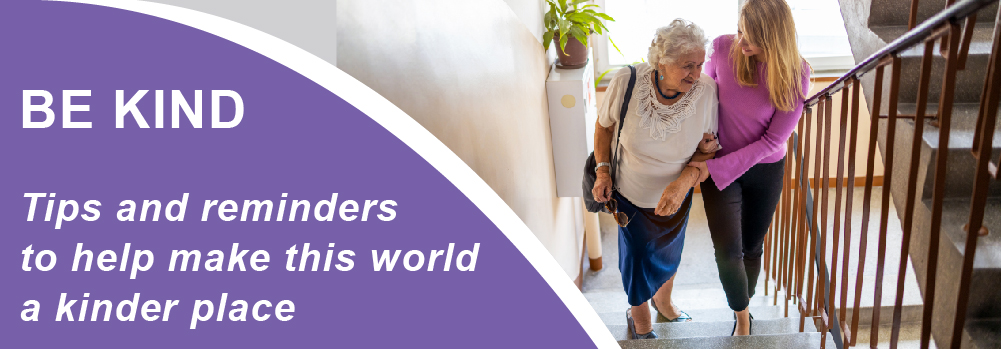
Tips and reminders to help make this world a kinder place
With what seems like the whole world being understaffed, people are working harder than ever to get your coffee order right, deliver your lunch on time, keep the checkout line moving and get you in and out of your appointment without delay.
People are enduring stressful jobs, worry about finances, illness, difficult relationships, overwhelming responsibilities, and the unknowns of the future. You never know when you may encounter someone that is carrying a heavy emotional load. Simple acts of kindness can make a big difference in someone’s life. It’s not always easy to be kind. It takes effort sometimes, especially when faced with a frustrating situation. Here are a few tips and tricks for when you feel your patience wearing thin.
Practice patience.
Waiting is never easy. Not in a line, not for a phone call, not in a waiting room. It’s common to feel frustrated when an appointment isn’t moving as quickly as you would like. The ability to remain calm when feeling frustrated (aka: patience), doesn’t always come easy. It takes practice and reminders. Sometimes you may have to remind yourself to exercise patience. Here are a couple things you can do when you feel your patience fading.
- Identify your triggers. Next time you lose your patience, or feel like you are going to lose your patience, stop and think about what was happening just before you lost your patience?
- Practice mindful breathing. Watch Dr. Alberto Nacif describe square breathing and how it can help calm you in times of anxiety or frustration.
- Get your sleep. When a child skips their nap, they are more likely to act out and have a harder time managing their feelings. Adults are similar. When sleepy, feelings of anger and frustration can feel more intense and rise much more quickly.
Make eye contact.
We spend so much time communicating over a screen or a phone that when we are standing in front of another person it can be difficult or awkward remembering how to behave. Make eye contact with the person in front of you. This let them know they have your attention. Even behind a mask, your smile can be felt by the person across from you.
Practice empathy.
Empathy really starts with curiosity. When you seek to understand another person’s feelings, situation and perspective, you’re view of that person that was so frustrating to you may shift. When you master empathy, getting along with others – from your most loved one to a complete stranger – happens much more naturally. So, when you feel like you are losing your cool with the person in front of you, try asking yourself questions like “how would I feel if I were them right now?”
Live a compassionate life.
When we set out to live with compassion the hope is that others will be inspired to do the same, so when you are the one carrying that heavy load, may you also be met with the same compassion you have given.
There really isn’t a bad time to be kind. Kindness is a gift that you can give to others, but also to yourself. When you are treated with kindness you will feel good both physically and mentally. But, you will also feel good when you treat others with kindness.
Think Outside the [Lunch] Box!

Sometimes school lunches can get boring – both for parents to make and for kids to eat. It’s pretty easy to fall into a lunch rut when packing lunch is just one of many tasks to check-off every morning. As you wrap up a month of another school year, we’ve got the recipe to keep boring lunches at bay.
Ditch the same old PB&J and try something new. We’re not suggesting rolling sushi in the wee hours of the morning. Keep it simple. Here are some of our lunch-time favorites:
• Hummus with pita bread and veggies for dipping
• Turkey slices rolled around a red pepper strip and cheese stick
• Whole grain mini bagel with cream cheese and sliced strawberries
• Tuna (with the pop-off lid) with cucumber slices and whole grain crackers
• Kebabs:
o Meat (cooked) with cheese and veggies
o Pieces of granola bar with fruit
o Waffles and fried chicken
o Grape tomatoes with mozzarella and basil leaves (don’t forget the balsamic vinegar drizzle!)
• Whole grain cereal, yogurt and blueberries
• A sliced hard-boiled egg, Canadian bacon and cheese on a whole grain English muffin
• Leftovers from dinner or soup in a thermal container
Include a note. Who doesn’t love a surprise? Wish your child good luck on a test, give them a pat on the back for a recent accomplishment, a note of encouragement or send a sweet message just because!
Use a fun lunch box. If the lunch box features your child’s favorite character or color they will enjoy bringing it to the table each day. Individual plastic containers are fun to fill and are a great tool to teach portion control, and keep things separated – Bento Box containers are a great option.
Be cool. Use a cold pack to keep food fresh and safe. They even come in fun colors!
Create a weekly meal plan. Have your child help plan their lunches each week. The planning process will help understand healthy eating by including a variety of food groups as well as encourage your child to try new foods (fingers crossed!). Get your weekly school lunch planner template here.
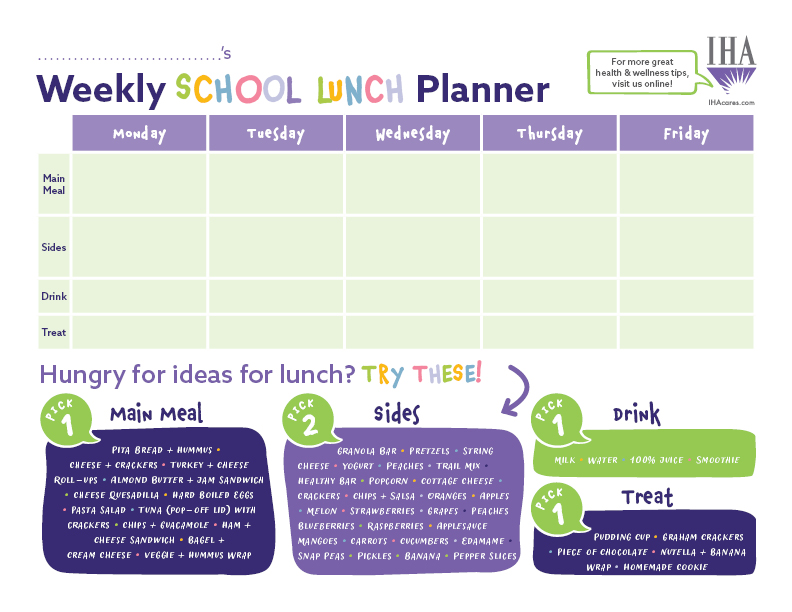
If you have any concerns around your child’s eating habits, connect with your pediatric provider. They’ll give you some food for thought.
Overloaded
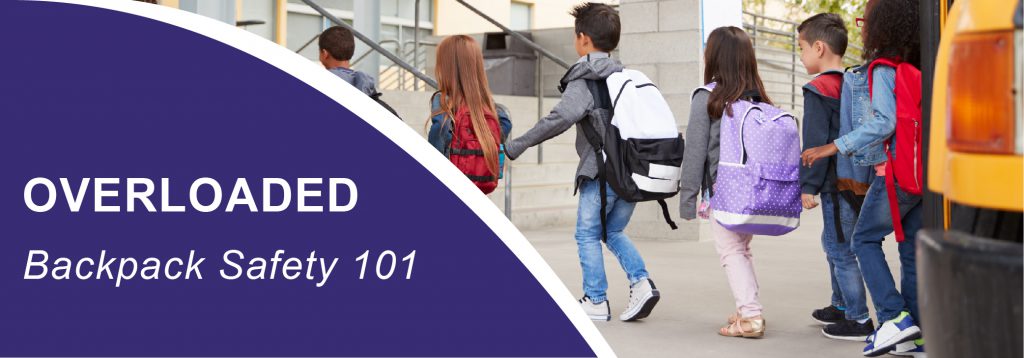
Backpack Safety 101
Does your child pull their backpack off as soon as they step off the bus or out of school, and request that you carry it for them? As a rule, a child’s backpack should not weigh more than 10% – 15% of their body weight, but many kids are carrying bags much heavier than that. If your child is complaining of a sore back, they struggle to put their backpack on or they learn forward to walk once they get it on, their backpack is most likely too heavy. Read on for some tips to ensure they have the right backpack for their needs and their body type, and they are packing light.
Get the right backpack.
- Discuss what will need to go in the backpack to ensure you get the right size
- Your child’s backpack should not be wider than their torso
- The backpack should not hang more than 4 inches below your child’s waist
- Padded shoulder straps are a necessity
- A padded back will help prevent objects from poking your child in the back
- Waist and chest straps will help your child distribute the load of their backpack when it’s packed
- Consider the weight of the backpack itself and choose one made of a lightweight material
Carry smart.
- Two straps distribute the weight of the backpack evenly, be sure your child is using both
- Adjust the straps to ensure a good fit for your child (remember the backpack should not hang more than 4 inches below the waist)
- Help decide what should come home every day, and what can be left in their locker
- When they must bring home a full pack, encourage your child to use their chest and waist straps
- Pack the heaviest items on the bottom, and make use of the multiple compartments to better distribute the load
To ensure you child is carrying a sensible weight, pick up their backpack once in a while, or weigh it on the bathroom scale. Make adjustments as needed to help keep your child’s back in great shape!
If your child is complaining of pain that doesn’t go away, make an appointment with your child’s pediatric provider. They’ve got your back!
Originally published October 2019
The COVID-19 Vaccine
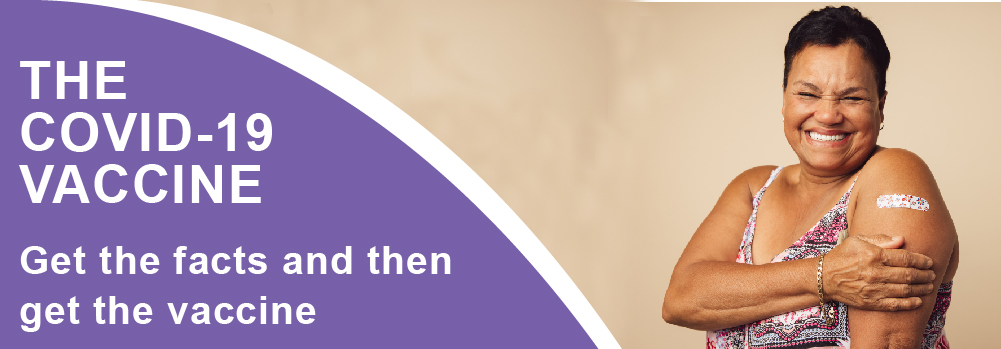
Get the facts, then get vaccinated
Studies show that the COVID-19 vaccine is effective at keeping you from getting COVID-19. Some people will test positive for the virus even after they are vaccinated, but all three vaccinations (Pfizer, Moderna and Johnson & Johnson) are highly effective in preventing symptomatic infections, hospitalizations, and death. In fact, more than 99% of people who die today from COVID-19 are unvaccinated. Every death and serious illness is preventable today. We know there are a lot of rumors, myths and misinformation out there making it hard for some people to get the vaccine. Our physicians have gathered the most common questions and concerns they are hearing from patients about the COVID-19 vaccine and providing the facts to help more people get vaccinated. Afterall, the vaccine is our very best shot for ending this pandemic.
What You Need to Know about the COVID-19 Vaccine:
• COVID-19 vaccines are safe and effective at preventing COVID-19 disease, especially severe illness and death.
• COVID-19 vaccines reduce the risk of people spreading the virus that causes COVID-19.
• You may have side effects after vaccination. These are normal and should go away in a few days.
• It typically takes two weeks after vaccination for the body to build protection (immunity) against the virus that causes COVID-19. You are not fully vaccinated until 2 weeks after the second dose of a two-dose vaccine or two weeks after a single-dose vaccine.
• After you are fully vaccinated, you can resume activities that you did before the pandemic.
• COVID-19 vaccines were evaluated in tens of thousands of participants in clinical trials.
• The vaccines met the Food and Drug Administration’s (FDA) rigorous scientific standards for safety, effectiveness, and manufacturing quality needed to support emergency use authorization (EUA) with formal FDA approval imminent and likely soon.
• These vaccines have undergone and will continue to undergo the most intensive safety monitoring in U.S. history.
• This monitoring includes using both established and new safety monitoring systems to make sure that COVID-19 vaccines are safe
• Permanent FDA approval is expected
What We Are Still Learning About the COVID-19 Vaccine
• How well the vaccines protect people with weakened immune systems, including people who take medicines that suppress the immune system
• How long COVID-19 vaccines protect people
• How many people have to be vaccinated against COVID-19 before the population can be considered protected (population immunity)
• How effective the vaccines are against new variants of the virus that causes COVID-19
What impact is the Delta Variant having on the urgency to get vaccinated?
• Rapidly spreading and now responsible for over 51% of new US cases, up from 30% two weeks ago
• 60% more transmissible than original COVID-19 strain
• States with low vaccination rates experiencing increase in new cases
• Vaccine protects against transmission so the more we vaccinate, the more we decrease chances of “escape variant” against which the vaccines would not work
• All three currently approved vaccines are highly effective in preventing symptomatic infections, hospitalizations and deaths
Why vaccinate when there are effective COVID-19 treatments?
• With proven effective treatments such as remdesivir, polyclonal antibodies, dexamethasone, deaths are still occurring
• Treatment will not curb the spread of this virus
• Preventing infection with vaccination also prevents long-term complications (Long-haul COVID)
• We fully support continued research into effective treatments
Do I need to get a booster dose of the vaccine?
• It may be required if there’s evidence that the vaccine’s protection against the virus weakens over time or if variants arise that require a booster. The FDA and ACIP (Advisory Community on Immunization Practices) continue to review data and will provide recommendations for boosters based on evidence and safety.
When can I get a COVID-19 vaccine booster?
• Not immediately. The goal is for people to start receiving a COVID-19 booster shot beginning in the fall, with individuals being eligible starting 8 months after they received their second dose of an mRNA vaccine (either Pfizer-BioNTech or Moderna). This is subject to authorization by the U.S. Food and Drug Administration and recommendation by CDC’s Advisory Committee on Immunization Practices (ACIP). FDA is conducting an independent evaluation to determine the safety and effectiveness of a booster dose of the mRNA vaccines. ACIP will decide whether to issue a booster dose recommendation based on a thorough review of the evidence.
If we need a booster dose, does that mean that the vaccines aren’t working?
• No. COVID-19 vaccines are working very well to prevent severe illness, hospitalization, and death, even against the widely circulating Delta variant. However, with the Delta variant, public health experts are starting to see reduced protection against mild and moderate disease. For that reason, the U.S. Department of Health and Human Services (HHS) is planning for a booster shot so vaccinated people maintain protection over the coming months.
What’s the difference between a booster dose and an additional dose?
• Sometimes people who are moderately to severely immunocompromised do not build enough (or any) protection when they first get a vaccination. When this happens, getting another dose of the vaccine can sometimes help them build more protection against the disease. This appears to be the case for some immunocompromised people and COVID-19 vaccines. CDC recommends moderately to severely immunocompromised people consider receiving an additional (third) dose of an mRNA COVID-19 vaccine (Pfizer-BioNTech or Moderna) at least 28 days after the completion of the initial two-dose mRNA COVID-19 vaccine series.
• In contrast, a “booster dose” refers to another dose of a vaccine that is given to someone who built enough protection after vaccination, but then that protection decreased over time (this is called waning immunity). HHS has developed a plan to begin offering COVID-19 booster shots to people this fall. Implementation of the plan is subject to FDA’s authorization and ACIP’s recommendation.
Why is vaccination necessary if I had COVID-19 and likely have antibodies?
• Vaccination produces a higher level of and longer lasting immunity than natural infection. This is uncommon in many illnesses but is true in COVID-19
• Vaccination produces broader protection against variants
We take safety seriously. That is why Trinity Health and IHA require colleagues, clinical staff, and contractors to be vaccinated against COVID-19. You can read more about our decision here: bit.ly/3jX5RGV
Do you need to schedule your COVID-19 vaccination? Click below to find a time and place that works best for you and your family.
